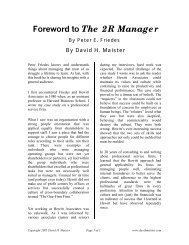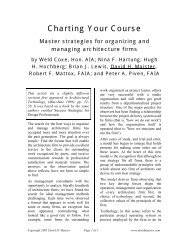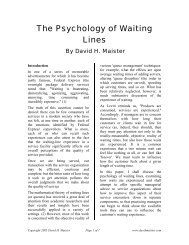pdf version - David Maister
pdf version - David Maister
pdf version - David Maister
Create successful ePaper yourself
Turn your PDF publications into a flip-book with our unique Google optimized e-Paper software.
Results and Rewards in The Multi-Group Firm<br />
Similarly, a high profit per officer does<br />
not necessarily mean that a group<br />
deserves an increase in compensation (or<br />
share of the profits). It might well be the<br />
case that the partners in a high-profitper-partner<br />
group are already fully<br />
compensated for their high levels of<br />
profit and that a low-profit-per-partner<br />
group is staffed with low income<br />
partners who do not deserve to be<br />
reduced.<br />
As a number of firms have discovered,<br />
there is a simple ratio that overcomes<br />
these issues—the use of an earnings per<br />
share (EPS) ratio. Here, share refers<br />
simply to the share of firm profits held<br />
by the partners in the office or group.<br />
Some firms have a “unit” system for<br />
dividing partnership profits, with each<br />
partner holding a certain number of units<br />
and each unit representing a fixed<br />
percentage claim on the firm’s profits. In<br />
such a case, one would calculate the<br />
earnings per unit of the group (EPU).<br />
Other firms do not use the term “units”<br />
but allocate percentage points, which is<br />
effectively the same thing. If a partner<br />
has a claim to 3.6 percent of the firm’s<br />
profits, then he or she can be said to hold<br />
3.6 units out of a total of 100 units.<br />
Under any of these systems, the EPS<br />
ratio can be calculated by dividing the<br />
profits of each group by the sum total of<br />
units, percentage points or even cash<br />
compensation held by the partners in the<br />
group. (Any one of these approaches<br />
will work as long as it is consistently<br />
applied.)<br />
The virtue of the EPS ratio is that it<br />
gives an immediate guide to which<br />
groups are candidates for increased<br />
profit allocation and which are<br />
candidates for reductions. Consider a<br />
group that on a three-year average basis<br />
has sustained a high EPS. By definition,<br />
this group has high earnings (profits)<br />
relative to the number of profit shares<br />
allocated to the partners in that group. A<br />
greater profit-share allocation might be<br />
in order.<br />
Similarly, any office with a low EPS<br />
(particularly if this is a three-year<br />
average) would have earnings that are<br />
low relative to the aggregate profit<br />
shares held by the partners in the group.<br />
In such a situation a (relative) share<br />
reduction might be called for.<br />
Of course, there are other action<br />
possibilities. Perhaps the firm has<br />
partners in that group who are too high<br />
powered to be working there (relative to<br />
the earning potential in that market), and<br />
they might better serve the firm by being<br />
deployed to better markets.<br />
A third possible action is to conclude<br />
that the low EPS is the result of a<br />
conscious strategic decision to invest<br />
“expensive” partner resources in a<br />
market that the firm is trying to nurture.<br />
Whatever the conclusion, the EPS ratio<br />
provides a convenient way to relate<br />
profitability to the set of decisions about<br />
where the firm’s “equity” should be<br />
located. Just as in industry, EPS is a<br />
measure of return on equity investment<br />
and provides guidance as to whether the<br />
firm is placing its valuable resources in<br />
the correct markets.<br />
As we noted above, no approach to<br />
partner reward should be formulaic and<br />
none should be conducted on a singleyear<br />
basis. However, a three-year<br />
average of EPS for each office and<br />
practice group, together with the use of<br />
the Health and Hygiene Indexes, will<br />
give a firm a good basis for discussion of<br />
how well it is matching results and<br />
rewards in a multigroup environment.<br />
Copyright 2005 <strong>David</strong> H. <strong>Maister</strong> Page 4 of 4 www.davidmaister.com











